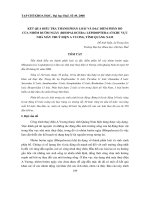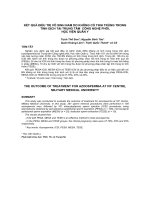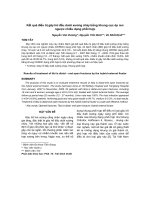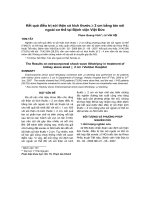Báo cáo nông nghiệp:" Kết quả điều tra nhiễm giun tròn ký sinh đường tiêu hoá của chó ở tỉnh Hà Tĩnh" potx
Bạn đang xem bản rút gọn của tài liệu. Xem và tải ngay bản đầy đủ của tài liệu tại đây (293.06 KB, 5 trang )
J. Sci. Dev. 2011, 9 (Eng.Iss.1): 16 - 20 HANOI UNIVERSITY OF AGRICULTURE
The current status of infection of intestinal nematodes in dogs
in Ha Tinh province
Kết quả điều tra nhiễm giun tròn ký sinh đường tiêu hoá của chó ở tỉnh Hà Tĩnh
Vo Thi Hai Le
1
and Nguyen Van Tho
2
1
Postgraduated student – Faculty of Veterinary Medicine, Hanoi University of Agriculture
2
Faculty of Veterinary Medicine, Hanoi University of Agriculture
Corresponding author email:
Received date: 16.08.2010 Accepted date: 10.04.2011
TÓM TẮT
Một nghiên cứu đã được tiến hành tại 2 huyện Đức Thọ và Cẩm Xuyên, tỉnh Hà Tĩnh, để tìm giun
tròn ký sinh đường tiêu hoá của chó. Kết quả kiểm tra 115 chó bằng phương pháp mổ khám cho thấy
có 5 loài giun tròn ký sinh đường tiêu hoá của chó, đó là: Ancylostoma caninum, Uncinaria
stenocephala, Toxocara canis, Toxascaris leonina và Spirocerca lupi. Tỷ lệ nhiễm giun tròn đường
tiêu hoá nói chung là 71,3%. Chó nhiễm giun móc A. caninum với tỷ lệ 57,63% - 62,5%. Kết quả xét
nghiệm 168 mẫu phân chó bằng phương pháp Füleborn cho thấy tỷ lệ nhiễm giun tròn đường tiêu
hoá nói chung là 70,24%. Giun móc họ Ancylostmatidae có tỷ lệ nhiễm dao động từ 59,77 đến 69,14%.
Giun thực quản S. lupi có tỷ lệ nhiếm thấp nhất là 11,49%. Chó từ 7 đến 12 tháng tuổi có tỷ lệ nhiễm
cao với các loài giun tròn đường tiêu hoá. Tỷ lệ nhiễm S. lupi tăng dần theo lứa tuổi của chó, trong
khi đó lại giảm dần đối với T. canis. Kết quả điều tra cũng cho thấy, chó bị nhiễm Ancylostmatidae ở
mọi lứa tuổi. Trong khi đó Trichuiris vulpis, Ancylostoma brazilience lại không tìm thấy ở chó trong
vùng nghiên cứu.
Từ khoá: Chó, giun tròn đường tiêu hoá, sự nhiễm, tỷ lệ lưu hành.
SUMMARY
A study was carried out in Duc Tho and Cam Xuyen districts of Ha Tinh provine to investigate
intestinal nematode infection in dogs. A total of 115 dogs were examined by autopsy. Results
showed that there were 5 species of intestinal nematodes parasiting in the examined dogs, which
were: Ancylostoma caninum, Uncinaria stenocephala, Toxocara canis, Toxascaris leonina, and
Spirocerca lupi. The prevalence of intestinal infection of the parasites in the dogs was 71.3%. The
prevalence of hookworm A. caninum varied from 57.63 to 62.5%. Results of examination of 168
faecal samples by Fülleborn method showed that the prevalence intestinal parasite infection in the
dogs was 70.24%. The prevalence of Ancylostomatidae varied from 59.77 to 69.14%. The prevalence
of S. lupi was least, being 11.49%. The prevalence of intestinal nematodes was found highest in
dogs of 7 - 12 months of age. The prevalence of S. lupi increased, while the prevalence of Toxocara
canis decreased with the age of dogs. Results also indicated that dogs of all ages were highly
infected with Ancylostomatidae. Whereas, Trichuiris vulpis, Anculostoma brazilience were not
found in dogs in the studied areas.
Key words: Dogs, intestinal nematodes, infection, prevalence.
16
The current status of infection of intestinal nematodes in dogs in Ha Tinh province
1. INTRODUCTION
In most of households in Vietnam, especially
in rural areas, dogs are always let wander with little
health care for. Recently, scientists have identified
13 species of parasitic nematodes which are
harmful to dogs. The parasites, especially intestinal
roundworms such as A. caninum, T. canis,
T.leonina , are very common in dogs.
In the North of Central Vietnam, especially the
provinces of Nghe An, Ha Tinh and Thanh Hoa
provinces, where land area is relatively large and
climatic characteristics represent of three different
ecological zones, there have been few studies on
parasites in dogs. So far, a study on intestinal
nematodes parasiting in dogs have been carried out
in Hue by Le Huu Nghi and Nguyen Van Due
(2000) showing that the prevalence in dogs of A.
caninum was 52.3%, T. canis 58.46%, and
T.leonina 40.76%.
This paper reports results of a recent research
work on the status of infection of intestinal
nematodes in dogs in Ha Tinh province to identify
parasitic nematodes parasiting in the intestines of
dogs and determine their prevalence as affected by
species, age of dogs as well as ecological zones.
2. METERIALS AND METHODS
A cross-sectional study was conducted in dogs
from February to June in three different ecological
regions, viz. urban, upland, and lowland areas, in
Cam Xuyen district and Duc Tho district of Ha Tinh
province. Faecal samples were collected randomly
from 168 dogs of different ages: under 6 months, 7 –
12 months, over 12 months. Nematode eggs were
detected by Fülleborn method on the day and
identified for species according to their morphological
features according to Mönnig’s method.
A total of 115 dogs were randomly selected for
autopsy and recovery of intestinal nematodes. After
autopsy, the gastrointestinal tract was opened along
its entire length. Nematodes were collected and
identifed for species lusing published taxonomic
reference (Phan The Viet et al., 1977). Counts of
eggs were determined using Mc.Master
’
s method.
Prevalence of nematode infection was
calculated based on the results of feacal
examination and autopsy showing percentages of
infected dogs out of/the examined dogs.
Differences between the studied areas were
evaluated by means of Chi- square (χ
2
).
3. RESULTS AND DISCUSSION
3.1. Prevalence of intestinal nematodes in dogs
Results of autopsy of 115 mature dogs and
examination of 168 faecal samples in Cam Xuyen
district and Duc Tho district of Ha Tinh province
are presented in Table 1.
In Cam Xuyen and Duc Tho dogs were infected
with 5 species of intestinal nematodes, which were:
Ancylostoma caninum, Toxascaris leonina,
Toxocara canis, Uncinaria stenocephala, Spirocerca
lupi. Trichuiris vulpis, which is a worm parasiting in
the caecum of dogs, was not found in the studied
areas. The found worm species usually parasite from
the oesophagus to the caecum of dogs.
The results of the present study are similar to
those reported by Pham Sy Lang et al. (1990) from
a study on classification of intestinal nematodes in
dogs in Hanoi. The author indicated that prasite
nematodes of the Ancylosotmatidae familly as well
as T. canis, T. leonina and T. vulpis species were
common parasites in dogs.
3.2. Prevalence and intensity of nematode infection
in dogs
Results in Table 2 show that the general
prevalence of infection with intestinal nematodes
in dogs was from 71.3% (by autopsy) to 70.24%
(by feacal examination). Prevalence of intestinal
nematodes infection was the same in both methods.
Table 1. Intestnal nematodes parasiting in of dogs in the studied areas
Name of nematodes Parasiting site Cam Xuyen Duc Tho
Spirocerca lupi (Rudolphi,1809) Oesophagus, stomach + +
Toxocara canis (Werner, 1782) Small intestine + +
Toxascaris leonina (Linstow), 1902) Small intestine + +
Ancylostoma caninum (Ercolani, 1859) Small intestine + +
Uncinaria stenocephala (Brumpt, 1922) Small intestine + +
Trichuris vulpis (Froelich, 1789) Caecum - -
17
Vo Thi Hai Le and Nguyen Van Tho
Table 2. Prevalence of infection with intestinal parasite in dogs in the study areas
Autopsy Feacal examination
Location
Examined
dogs
Infected
dogs
Prevalence
(%)
Examined
dogs
Infected
dogs
Prevalence
(%)
Cam Xuyen 56 39 69.64 81 55 67.90
Duc Tho 59 43 72.88 87 63 72.41
Total 115 82 71.3 168 118 70.24
Table 3. Prevalence and intensity of intestinal nematodes in dogs as found by autopsy
Cam Xuyen (n = 56) Duc Tho (n = 59)
Nematodes species
Infected
dogs
Prevalence
(%)
Intensity
(min-max)
Infected
dogs
Prevalence
(%)
Intensity
(min-max)
Toxocara canis 18 32.14 1 – 6 20 37.89 2 – 7
Toxascaris leonine 20 35.71 2 – 8 14 23.73 5 – 10
Ancylostoma caninum 35 62.5 18 – 42 34 57.63 10 – 50
Uncinaria stenocephala 15 26.78 30 – 72 14 23.73 17 – 80
Spirocerca lupi 10 17.86 3 - 11 11 18.64 1 – 8
The most frequently found intestinal parasites
in dogs are nematodes. Nematodes such as T.canis,
T.leonina, U.stenocephala and A.caninum are
common parasites in the alimnetary tract of
carnivorous animals. Some of them sush as T. canis
and A.caninum can infect humans without specific
symptoms or signs of hookworm infection.
(Beaver, 1952; Woodruf, 1970; Prociv and Croese,
1990). In the present study, the prevalence of
intestinal nematodes was found high in Cam Xuyen
and Duc Tho, varrying from 69.64% to 72.88% by
necropsy and from 67.90% to 72.41% by feacal
examination. The prevalence of intestinal
nematodes in dogs was not significantly different
between Cam Xuyen (69.64%) and Duc Tho
(72.88%) (P> 0.05). The prevalences as fount by
the two methods were not significantly different.
The results of the present study is in
accordance with the actual physical and dog raising
conditions in the two lowland districts. , in which
dogs were kept unbridled with little health care,
which should have resulted in so high nematode
infection rates in dogs of all ages.
Results in Table 3 show that with both
methods, Fülleborn
‘
s and autopsy, A. caninum, T.
canis, T. leonina, S. lupi were were decteced.
Whereas, in faeces only eggs of large hookworm
Ancylostoma spp and roundworm T. canis were
deteced. The prevalence of T. leonina in dogs was
35.71% in Cam Xuyen and 23.37% in Duc Tho.
The respective figures for T. canis were 32.14%
and 37.89%.
There have been many studies on genaral
prevalence of intestinal nematodes in dogs in
Vietnam. Pham Van Khue et al. (1993) indicated
that in Ha Noi 20.2% of dogs were infected with T.
canis, 29.4% with T. leonina, and 59.7% with A.
caninum. Tran Xuan Mai (1992) also showed that
in some Southern provineces 76.11% free roaming
stray dogs were inffected with helminths with the
highest prevalence of hookworm (55.35%). Stray
dogs may have an important role in the
transmission of some diseases and potential
nematodes in dogs and other animals closely
associated with human. Therefore, it is necessary
for human beings to avoid contamination of feaces
in streets and parks.
The eggs of nematodes from the
Ancylostomatidae family and T.canis, T. leonina
and S.lupi species were found in many samples. In
the present investigation, the most frequently found
eggs werefrom the Ancylostomatidae family with
two species, viz. A. caninum and U. stenocephala.
The most frequent parasites were nematodes from
the Ancylostomatidae family with a prevalence ofof
59.77% in Duc Tho and 69.14% in Cam Xuyen.
This family ia normally one of the most common
intestinal parasites in dogs, especially puppies and
kittens, and can cause severe symptoms, including
anemia and serious diarrhea. A. braziliense and
Trichuiris vulpis species were not found in the
studied areas (Table 4).
18
The current status of infection of intestinal nematodes in dogs in Ha Tinh province
Table 4. Prevalence and intensity of intestinal nematodes in dogs as found by examination of feaces
Cam Xuyen (n = 81) Duc Tho (n = 87)
Species
Infected
dogs
Prevalence
(%)
Egg count per
gram feaces
Infected
dogs
Prevalence
(%)
Egg count per
gram feaces
T. canis 34 41.98 620 20 22.99 572
T. leonine 22 27.16 318 26 29.89 327
Ancylostomatidae 56 69.14 782 52 59.77 802
S. lupi 13 16.05 207 10 11.49 214
Table 5. Infection of intestinal nematodes in dogs by age
≤ 6 months
(n = 48)
7 – 12 months
(n = 113)
> 12 months
(n = 122)
Species
Infected
dogs
Prevalence
(%)
Infected
dogs
Prevalence
(%)
Infected
dogs
Prevalence
(%)
Spirocerca lupi
0 0 14 12.39 32 26.23
Toxocara canis
25 52.08 41 36.28 26 21.31
Toascaris leonina
14 29.17 46 40.71 22 18.03
Ancylostomatidae
29 60.42 73 64.6 79 64.75
A study carried out by Fok et al. (2001) in
eastern and northern regions of Hungary found that
T. canis eggs were observed in 24.3 – 30.1% of the
feacal samples, whereas T. leonina eggs found only
in 2.1% of the faecal samples. According to the
present results, only 10 -13 of of 81 dogs were
infected with S lupi, with a prevalence of infecton
being 11.49 - 16.05%.
The intensity of infection of Ancylostomatidae
species was highest at all locations studied, ranging
from 782 to 802 eggs/g faeces. The infection
intensity of T. canis was quite high, ranging from
572 to 620 eggs/g faeces. The infection intensity of
T. leonina was lower varying from 318 to 327
eggs/g faeces.
3.3. Infection of intestinal nematodes in dogs as
affected by age
Dogs infected with roundworms were grouped
into three different age ranges as presented in
Table 5. It can be seen that dogs in the different age
groups were infected with the worms at different
prevalences.
It is common to observe intestinal nematodes
in canine of all ages, but the prevalence of infection
is usually high in puppies. The present study
revealled that the prevalence of S. lupi increased
with age of dogs; the highest infection rate was in
the age group over 12 months (26.63%). Dogs from
7 to 12 months of age were infected at a rate of
12.39%. S.lupi was not found in dogs under 6
months of age. Dogs of all ages were infected with
T. canis and T. leonina, whichare the two common
species of worms living in the intestines of almost
all newborn pupies. The prevalence of T.canis was
highest in dogs under 6 months (52.08%) and
decreased with age of the dog. T.leonina was found
in 40.71% 7 - 12 month old dogs lower in dogs
under 6 months old and lowest in dogs over 12
months of age (18.03%).
Ngo Huyen Thuy (1996) investigated infection
of intestinal nematodes in dogs in Ha Hoi. In the
study 516 dogs were examined by autopsy and
1092 feacal samples were tested. Results showed
that hookworm infection rate was very high, being
81.65% for Ancylostoma caninum and 73.07% for
Uncinaria stenocephala. The feaccal test showed
that eggs of U. stenocephala were found in 57.77%
samples. The author also mentioned that the
prevalence of infection of hookworms in dogs was
not by sex, but by age.
4. CONCLUSIONS
From the above presented research results, it
can be concluded that:
There were 5 species of nematodes, viz.
Spirocerca lupi, Toxocara canis, Toxascaris
19
Vo Thi Hai Le and Nguyen Van Tho
leonina, Ancylostoma caninum and Uncinaria
stenocephala, which parasited in the alimentary
tract of dogs in Cam Xuyen and Duc Tho districts
of Ha Tinh province.
The prevalence of intestinal nematodes in dogs
in the studied areas was high by autopsy (69.64% in
Cam Xuyen and 72.88% in Duc Tho). Ancylostoma
caninum had the highest infection rate (60.06%),
followed by T. canis (33.02%) and S. lupi
(18.25%). The results were confirmed by feacal
examination showing that Ancylostomatidae had
the highest infection rate (64.35%), followed by
Toxocara canis (33.02%), and S. lupi (18.25%).
The prevalence of infection of intestinal
nematodes was influenced by age of the dog.
- Spirocerca lupi: The prevalence increased
with the age of dogs.
- Toxocara canis: The prevalence decreased
with the age of dogs. .
- Toxascaris leonina: The highest prevalence
was in 7-12 month old dogs (40,71%) and lowest in
dogs over 12 months of age (18.03%).
- Ancylostomatidae: The prevalence was high
in all age groups.
REFERENCES
Beaver, P.C (1952). Chronic eosinophilia due to
visceral larva mirgrans. Pediatrics, 9: 7 - 19.
Fox, E
,
., V. Szatma
,
ri, K. Bvsa
,
k, F. Rozgonyi
(2001). Prevalence of intestinal parasites in dogs
in some urban and rural areas of Hungary. Vet.
Quart. 23: 96 – 98.
Pham Van Khue, Tran van Quyen, Doan Van Phuc
(1993). Commenting on the helnimths parasites
of dogs in Ha Noi, (The study Agricultural
University number one).
Agricultural Publishing
House, Hanoi.
Pham Sy Lang, Le Thanh Hai, Nguyen Thi Rat
(1990).
Dog hookworm disease in Vietnam,
(The study science and engineering, from 1990
to 1991), Agricultural Publishing House, Hanoi.
Tran Xuan Mai (1995).
Contributing to research a
parasitic disease dimensional (impasse parasitic)
infection transmitted to humans through from
dogs and cats, PhD thesis deal of scientific
medicine, Medicine University.
Le Huu Nghi and Nguyen Van Due (2000).
Prevalence of Helminthes in dogs in Hue City
and effectivity of harmful drugs. Veterinary
Science and Technology. Vol 7, (4), 58.
Prociv, P., J.Croese (1990). Human eosinophilic
enteritis caused by dog hookworm Ancylostoma
caninum. Lancet, 335: 1302 - 1306.
Trinh Van Thinh (1963). Veterinary Parasitology.
Rural Publishing House, Hanoi.
Ngo Huyen Thuy (1996). Helminth parasitic
alimentary tract of dogs in Hanoi and some
characteristics of Spirocerca lupi,
PhD thesis
deal of Agriculture, National Veterinary
Institute.
Phan The Viet, Nguyen Thi Ky, Nguyen Thi Le,
(1977). Helminth parasites in animals Vietnam,
Publisher of Science & Technology, Hanoi.
Woodruff, A.W. (1970). Toxocariasis. Br. Med. J.,
3: 663 – 669.
20









